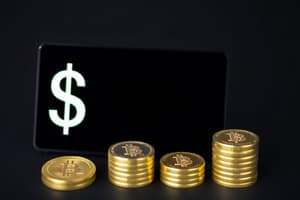Podcast
Questions and Answers
What is the primary reason for a company to repurchase its own shares?
What is the primary reason for a company to repurchase its own shares?
- To decrease the dividend payout ratio
- To reduce the company's cash reserves
- To boost the company's financial position and increase equity value (correct)
- To increase the total number of outstanding shares
How does a share repurchase impact a company's financial statements?
How does a share repurchase impact a company's financial statements?
- It reduces the company's total assets (correct)
- It has no impact on the company's financial statements
- It increases the company's liabilities
- It increases the company's available cash
Which of the following is NOT a reason for a company to repurchase its shares?
Which of the following is NOT a reason for a company to repurchase its shares?
- To improve return on assets and return on equity
- To boost the company's earnings per share (EPS)
- To increase the dividend payout ratio (correct)
- To consolidate and reduce the number of outstanding shares
What happens to the repurchased shares after a share buyback?
What happens to the repurchased shares after a share buyback?
What is the impact of a share repurchase on a company's dividend payout ratio?
What is the impact of a share repurchase on a company's dividend payout ratio?
Flashcards are hidden until you start studying
Study Notes
Dividend Payout Ratio
- The dividend payout ratio is the percentage of a company's earnings distributed to shareholders in the form of dividends.
- Formula: (Total Dividends / Net Income) * 100%
- A high dividend payout ratio indicates that a large portion of the company's earnings is being distributed to shareholders, leaving less for reinvestment in the business.
- A low dividend payout ratio suggests that the company is retaining more of its earnings to reinvest in growth opportunities or to build up reserves.
Share Repurchase
- A share repurchase is a transaction whereby a company buys back its own shares from the marketplace.
- Reasons for share repurchases include:
- Reducing the cost of capital
- Ownership consolidation
- Preserving stock prices
- Undervaluation
- Boosting key financial ratios
- Share repurchases reduce the number of outstanding shares, which can drive up share prices.
- Share repurchases fill the gap between excess capital and dividends, allowing the business to return more to shareholders without locking into a pattern.
Advantages of Share Repurchases
- A share repurchase shows the corporation believes its shares are undervalued and is an efficient method of putting money back in shareholders' pockets.
- Share repurchases reduce the number of existing shares, making each worth a greater percentage of the corporation.
- The stock's EPS increases, which means the price-to-earnings ratio (P/E) will decrease, assuming the stock price remains the same.
Disadvantages of Share Repurchases
- A criticism of buybacks is that they are often ill-timed, with companies buying back shares when they have plenty of cash or during a period of financial health.
How Share Repurchases Work
- Share repurchases take place when companies decide to buy back their stock from the open market or directly from investors.
- After repurchase, the shares are canceled or held as treasury shares, so they are no longer held publicly and are not outstanding.
- Share repurchases impact a company's financial statements in various ways, including:
- Reducing available cash, reflected on the balance sheet as a reduction by the amount spent on the buyback.
- Reducing the total assets of the business, improving metrics such as return on assets, return on equity, and others.
Reasons for Share Repurchases
- Reducing the number of shares means earnings per share (EPS) can grow more quickly as revenue and cash flow increase.
- If the business pays out the same amount of total money to shareholders annually in dividends and the total number of shares decreases, each shareholder receives a larger annual dividend.
Studying That Suits You
Use AI to generate personalized quizzes and flashcards to suit your learning preferences.




